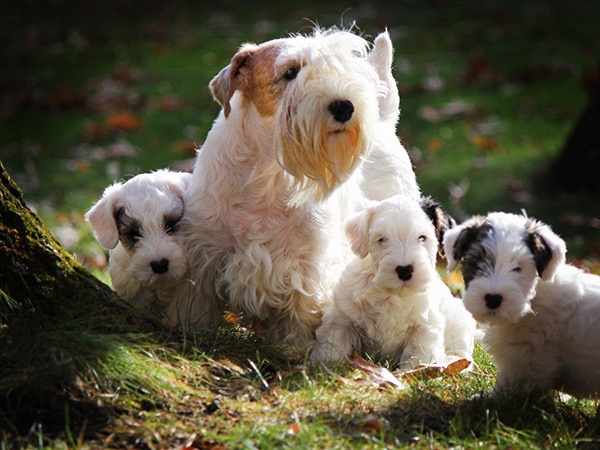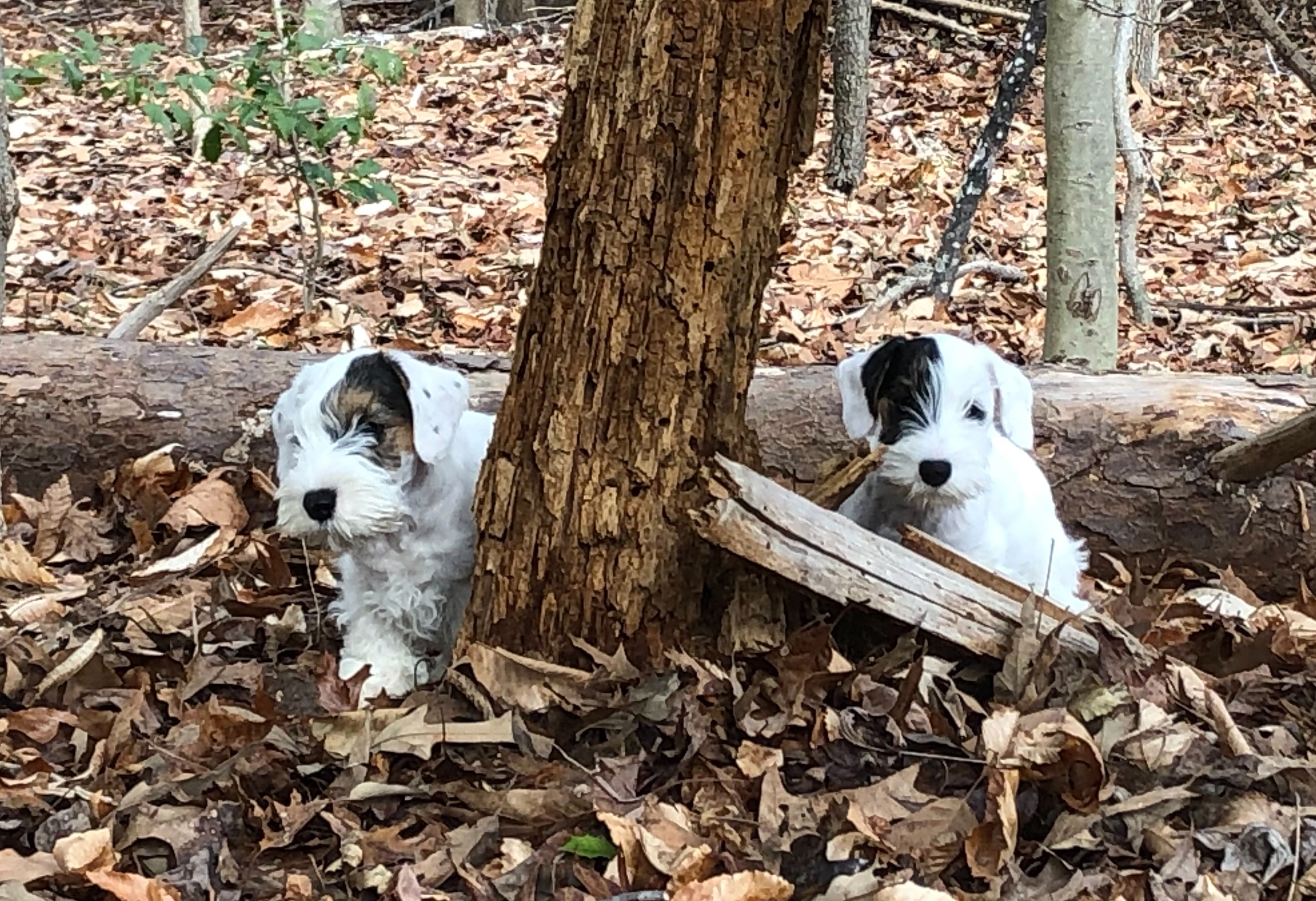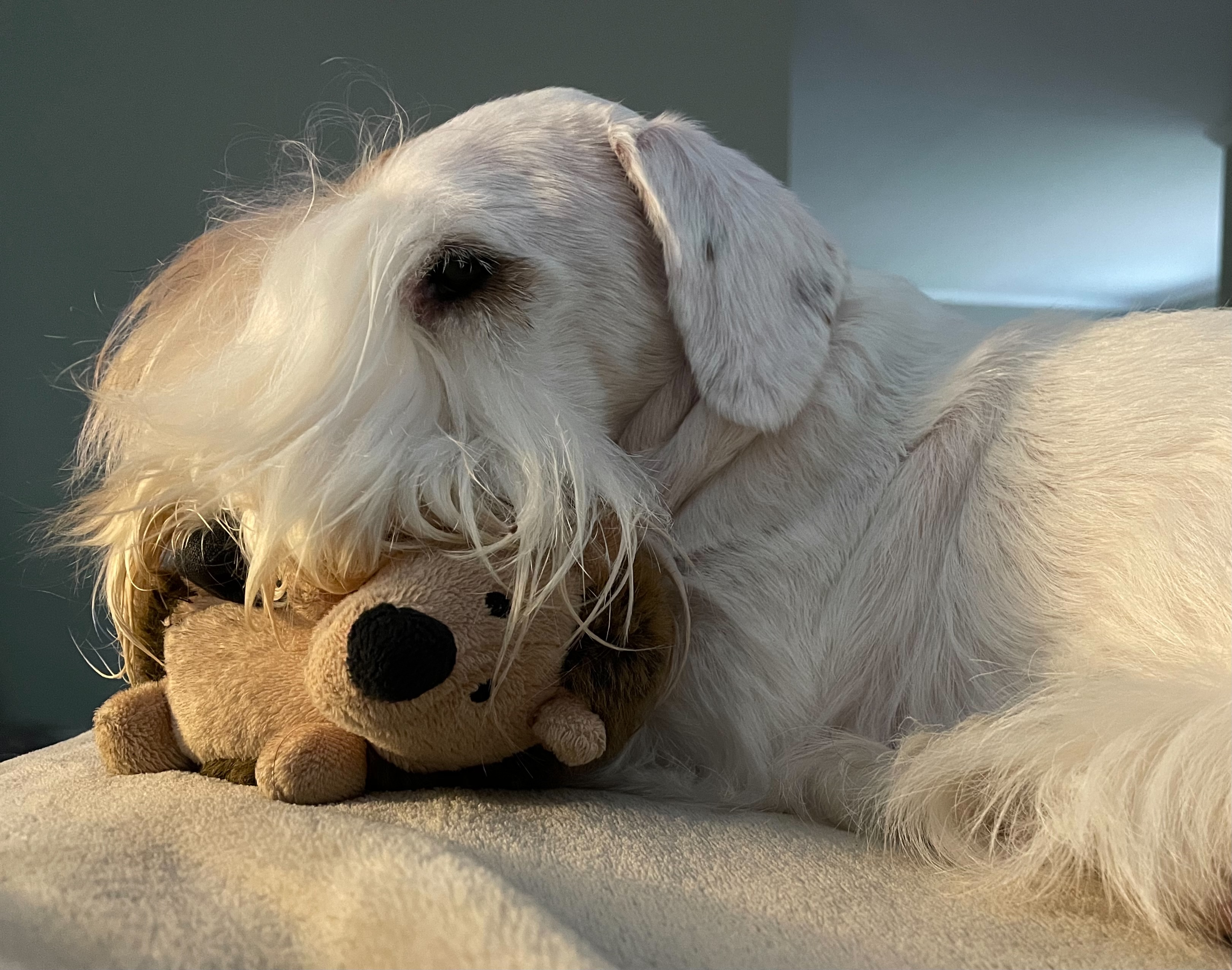551 – Sealyham Terriers: Favorites of Royalty and Hollywood
Sealyham Terriers: Favorites of Royalty and Hollywood

Leslie Jaseph with two of her Seabrook Sealyham Terriers.
Leslie Jaseph joins host Laura Reeves for the next in our Love the Breeds Month, by listener request, Sealyham Terriers.
Sealyham Terriers were once the favored breed of Queen Elizabeth’s sister, Princess Margaret, and Hollywood legends from Alfred Hitchcock to Betty Davis, Rock Hudson and Cary Grant. Today they are ranked 139th out of the 197 AKC breeds by registration numbers.
Developed in Wales and named for the founder’s estate, Sealyhams were used to go to ground after badgers and run with the Otterhounds hunting otters.
 Jaseph, a Sealyham breeder, owner and exhibitor for 50 years, showed her first Sealy in Junior Showmanship.
Jaseph, a Sealyham breeder, owner and exhibitor for 50 years, showed her first Sealy in Junior Showmanship.
“They’re tough in the field,” Jaseph said. “And they’re really engaging. They love to chase and run and track, but they’re not aggressive with other dogs. They are a pack animal, so their pack is their home. Beyond their pack they can be a little more assertive in personality, but within their pack it’s a very distinct order.
“They’re happy to be the boss of the house. If you don’t want to do that, they’ll take over. They’ll be in control. But you might not like how that works. So, you do have to be to stay strong, although you don’t want to be heavy-handed with them at all.
 “They’re very bright, they’re very inquisitive. They have a terrific sense of humor. They do things for effect and watch if you’re paying attention, and then they’ll repeat it. Or maybe sometimes if they see you watching, they’ll just stop and walk away.
“They’re very bright, they’re very inquisitive. They have a terrific sense of humor. They do things for effect and watch if you’re paying attention, and then they’ll repeat it. Or maybe sometimes if they see you watching, they’ll just stop and walk away.
“They were bred to be a dwarf breed, and so they have nice bone. I think our standard mentions strength and power something like 10 times within the opening paragraph and getting into the standard. Good bone, not overdone. Not coarse, still able to be agile.
“I know Sealys that live very, very happily with cats, that’s not a problem. But as far as rodents and other things like that, I think you would need to be very judicious on how you handled that situation. I actually take ours and we’ve done urban rat hunting in Washington DC and so they do have an instinct to do that.
 “So the reason why they’re white is because Captain Edwards wanted them to be able to be spotted when they were out hunting. Now, granted, when you’re in the mud, you’re going to get muddy, but you’re still going to have that white. But a good coated Sealyham really is a dog that the dirt doesn’t cling to them.
“So the reason why they’re white is because Captain Edwards wanted them to be able to be spotted when they were out hunting. Now, granted, when you’re in the mud, you’re going to get muddy, but you’re still going to have that white. But a good coated Sealyham really is a dog that the dirt doesn’t cling to them.
“If they have that harsh, crisp coat, they really don’t stain at all. And they do have a double coat. So you have this 50% harsh coat, 50% undercoat, which was weather resistant and kept them warm and somewhat dry.”
 “They do love their people and they want to be with their people. They’re wonderful companions. They love to go for walks. They don’t need to go running, but they do enjoy being with you as companion dogs.”
“They do love their people and they want to be with their people. They’re wonderful companions. They love to go for walks. They don’t need to go running, but they do enjoy being with you as companion dogs.”
238 — The friendships and journeys of a successful owner-handler
Sealyham Terrier owner-handler at the 2018 Westminster Kennel Club
Olga Forlicz and Leslie Jaseph, Sealyham Terriers breeders, share stories about the international friendships and journeys of a successful breeder owner-handler.
Details matter
Jaseph shares her experience showing in the hyper competitive East Coast terrier groups, many of which are dominated by top professional handlers.
“You have to go in the ring with your dog trained and prepared like any other person in the ring,” Jaseph said. “You have to understand preparation and trimming. You can’t make an excuse. You and your dog have to be prepared.”
No excuses
Jaseph’s highly successful bitch was entered at Westminster Kennel Club, but she didn’t bring her because she wasn’t quite back to top condition from her litter of puppies.
“You have to have high standards,” Jaseph said. “Never bring your dog out unless you feel it can win.”
US versus Europe
Forlicz, who lives in Poland and is the breeder of Jaseph’s competitive bitch, compared European and American shows. She said that the general level of grooming and overall presentation is much higher here in the US.
“In Europe we have famous breeders, but not as many professional handlers,” Forlicz said. “It is maybe easier for the average person to compete at a high level.”
Forlicz added that while there are more shows in the US, Entries are typically much larger in Europe.
International partnership
Jaseph approached Forlicz to purchase a dog because she was “looking for something tightly bred, that phenotypically was a good match for anything in the US.”
Breeders should “Get out your ruler and measure the dog,” Jaseph said. “Compare it to standard, break it down.” She also noted that within style variations, balance is the key in the breed.
Her general assessment of the breed, although it is numerically threatened worldwide, is that overall coats and movement are good. Her observation is that breeders should pay attention to tailsets and the length and strength of heads.
The full-length video interview also is available at the Pure Dog Talk YouTube channel, here: https://www.youtube.com/watch?v=6qr5CEfpFIk


